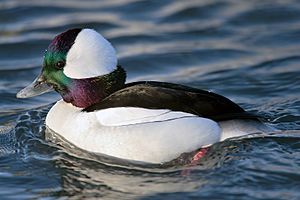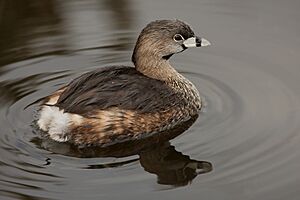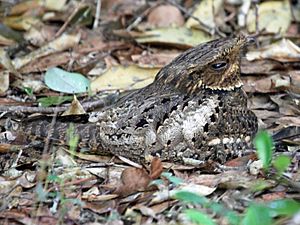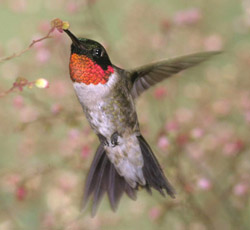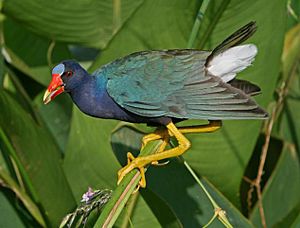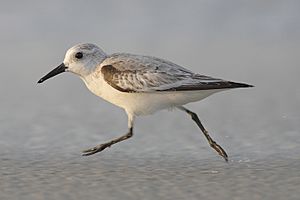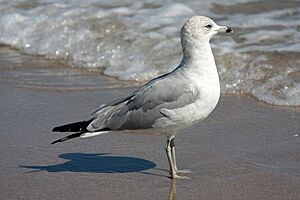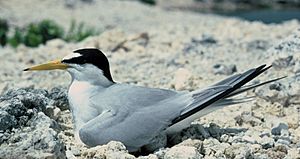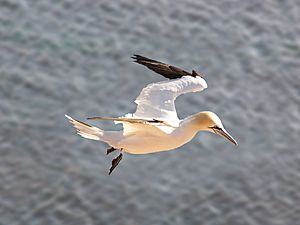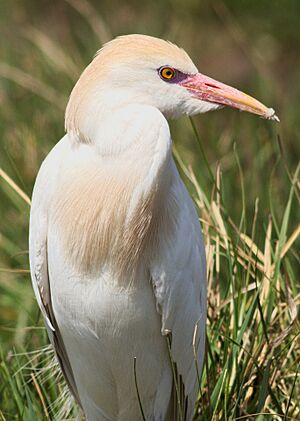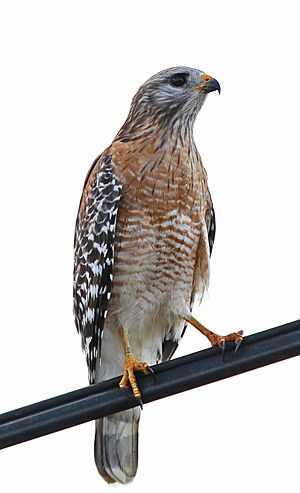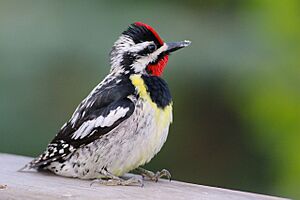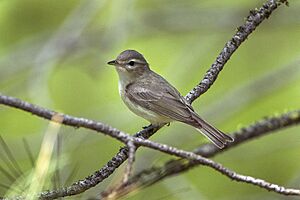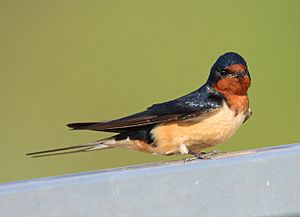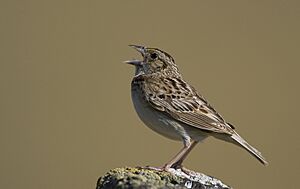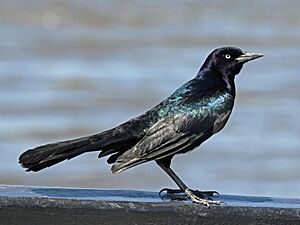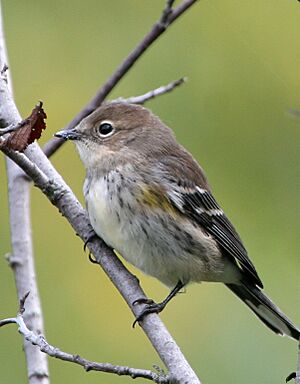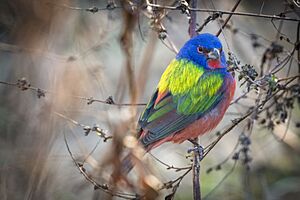List of birds of Dry Tortugas National Park facts for kids
Dry Tortugas National Park in Florida is a special place where many different kinds of birds come to visit or live. This list tells you about all the amazing bird species that have been seen there!
The park's official bird list, from February 2004, included 281 different types of birds. Some birds are seen often, while others are quite rare. Here's what the special codes next to some bird names mean:
- (O) Occasionally observed: These birds have been seen only 1 to 5 times during the season when they are most common.
- (R) Rarely observed: These birds have been seen 6 to 10 times during the season when they are most common.
- (B) Breeding: These birds are known to build nests and raise their babies in the park.
- (B?) Possibly breeding: We think these birds might breed in the park, but it's not confirmed yet.
- (I) Introduced: These birds were brought to North America by people, either on purpose or by accident, and now live in Florida.
- (E) Extinct: This means the bird species no longer exists anywhere in the world.
This list follows a special scientific order called "taxonomic sequence," which groups birds by their families and how they are related. The names come from the American Ornithological Society (AOS) and Clements taxonomy.
Contents
- Ducks, Geese, and Waterfowl: Pond Pals
- Flamingoes: Pink Waders
- Grebes: Diving Birds
- Pigeons and Doves: Common Visitors
- Cuckoos: Long-Tailed Birds
- Nightjars and Allies: Night Flyers
- Swifts: Masters of Flight
- Hummingbirds: Tiny Hoverers
- Rails, Gallinules, and Coots: Shy Water Birds
- Limpkin: A Unique Wader
- Cranes: Elegant Dancers
- Stilts and Avocets: Long-Legged Waders
- Oystercatchers: Shellfish Eaters
- Plovers and Lapwings: Open Country Birds
- Sandpipers and Allies: Shoreline Foragers
- Skuas and Jaegers: Powerful Seabirds
- Auks, Murres, and Puffins: Ocean Dwellers
- Gulls, Terns, and Skimmers: Coastal Birds
- Tropicbirds: Long-Tailed Beauties
- Loons: Diving Water Birds
- Southern Storm-Petrels: Small Seabirds
- Northern Storm-Petrels: Ocean Flyers
- Shearwaters and Petrels: Tube-Nosed Birds
- Frigatebirds: Aerial Acrobats
- Boobies and Gannets: Plunge Divers
- Anhingas: Snakebirds
- Cormorants and Shags: Dark Water Birds
- Pelicans: Pouch-Beaked Birds
- Herons, Egrets, and Bitterns: Wading Wonders
- Ibises and Spoonbills: Unique Bills
- New World Vultures: Nature's Clean-Up Crew
- Osprey: Fish Hunters
- Hawks, Eagles, and Kites: Birds of Prey
- Barn-Owls: Heart-Faced Hunters
- Owls: Nighttime Hunters
- Kingfishers: Fisher Birds
- Woodpeckers: Tree Tappers
- Falcons and Caracaras: Fast Hunters
- Tyrant Flycatchers: Insect Eaters
- Vireos, Shrike-Babblers, and Erpornis: New World Songbirds
- Shrikes: Impaling Hunters
- Crows, Jays, and Magpies: Smart Birds
- Tits, Chickadees, and Titmice: Woodland Birds
- Swallows: Aerial Feeders
- Kinglets: Tiny Crowned Birds
- Waxwings: Silky Plumage Birds
- Gnatcatchers: Small Insect Eaters
- Wrens: Loud Singers
- Mockingbirds and Thrashers: Amazing Mimics
- Starlings: Social Birds
- Thrushes and Allies: Ground Feeders
- Old World Sparrows: Seed Eaters
- Wagtails and Pipits: Ground Foragers
- Finches, Euphonias, and Allies: Cone-Billed Birds
- New World Sparrows: Distinctive Head Patterns
- Spindalises: Caribbean Natives
- Yellow-Breasted Chat: A Unique Songbird
- Troupials and Allies: Colorful New World Birds
- New World Warblers: Tiny, Bright Insectivores
- Cardinals and Allies: Strong-Billed Seed Eaters
- Tanagers and Allies: Colorful Omnivores
- See also
Ducks, Geese, and Waterfowl: Pond Pals
Order: Anseriformes • Family: Anatidae
This family includes ducks, geese, and swans. These birds are experts at living in water! They have webbed feet for swimming, flat bills for finding food, and special oily feathers that shed water easily.
- Fulvous whistling-duck, Dendrocygna bicolor (O)
- Snow goose, Anser caerulescens (O)
- Canada goose, Branta canadensis (O)
- Blue-winged teal, Spatula discors
- Northern shoveler, Spatula clypeata (O)
- Gadwall, Mareca strepera (O)
- Mallard, Anas platyrhynchos (O)
- Northern pintail, Anas acuta (O)
- Green-winged teal, Anas crecca (O)
- Ring-necked duck, Aythya collaris (O)
- Lesser scaup, Aythya affinis (O)
- Common eider, Somateria mollissima (O)
- Hooded merganser, Lophodytes cucullatus (O)
- Red-breasted merganser, Mergus serrator
Flamingoes: Pink Waders
Order: Phoenicopteriformes • Family: Phoenicopteridae
Flamingoes are tall, social wading birds, usually about 3 to 5 feet (1 to 1.5 meters) tall. They are found in many parts of the world. Flamingos eat shellfish and algae by filtering them from the water. Their unique beaks are shaped to separate mud from their food and are used upside-down!
- American flamingo, Phoenicopterus ruber (O)
Grebes: Diving Birds
Order: Podicipediformes • Family: Podicipedidae
Grebes are small to medium-sized birds that dive in freshwater. They have special lobed toes that make them excellent swimmers and divers. However, their feet are set far back on their bodies, so they are a bit clumsy on land.
- Pied-billed grebe, Podilymbus podiceps (O)
Pigeons and Doves: Common Visitors
Order: Columbiformes • Family: Columbidae
Pigeons and doves are birds with sturdy bodies, short necks, and slender bills. They have a fleshy area at the base of their bill called a cere.
- Rock pigeon, Columba livia (I) (R)
- White-crowned pigeon, Patagioenas leucocephala (O)
- Eurasian collared-dove, Streptopelia decaocto (I) (O)
- Common ground dove, Columbina passerina (O)
- Ruddy quail-dove, Geotrygon montana (O)
- White-tipped dove, Leptotila verreauxi (O)
- White-winged dove, Zenaida asiatica
- Zenaida dove, Zenaida aurita (O)
- Mourning dove, Zenaida macroura
Cuckoos: Long-Tailed Birds
Order: Cuculiformes • Family: Cuculidae
This family includes cuckoos, roadrunners, and anis. These birds vary in size and have slender bodies, long tails, and strong legs.
- Yellow-billed cuckoo, Coccyzus americanus
- Mangrove cuckoo, Coccyzus minor (B?) (O)
- Black-billed cuckoo, Coccyzus erythropthalmus (R)
- Smooth-billed ani, Crotophaga ani (B?) (R)
Nightjars and Allies: Night Flyers
Order: Caprimulgiformes • Family: Caprimulgidae
Nightjars are medium-sized birds that are active at night. They usually nest on the ground. They have long wings, short legs, and very short bills. Their soft feathers are colored to help them blend in with bark or leaves.
- Lesser nighthawk, Chordeiles acutipennis (O)
- Common nighthawk, Chordeiles minor
- Antillean nighthawk, Chordeiles gundlachii (R)
- Chuck-will's-widow, Antrostomus carolinensis
- Eastern whip-poor-will, Antrostomus vociferus (O)
Swifts: Masters of Flight
Order: Apodiformes • Family: Apodidae
Swifts are small birds that spend most of their lives flying. They have very short legs and almost never land on the ground. Instead, they perch on vertical surfaces. Many swifts have long, swept-back wings that look like a crescent moon.
- Black swift, Cypseloides niger
- Chimney swift, Chaetura pelagica
Hummingbirds: Tiny Hoverers
Order: Apodiformes • Family: Trochilidae
Hummingbirds are tiny birds famous for hovering in mid-air. They flap their wings incredibly fast. They are the only birds that can fly backward!
- Ruby-throated hummingbird, Archilochus colubris
- Black-chinned hummingbird, Archilochus alexandri (O)
Rails, Gallinules, and Coots: Shy Water Birds
Order: Gruiformes • Family: Rallidae
This is a large family of small to medium-sized birds. It includes rails, crakes, coots, and gallinules. They usually live in thick plants near lakes, swamps, or rivers. They are often shy and hard to spot. Most have strong legs with long toes and short, rounded wings. They are not very strong fliers.
- Clapper rail, Rallus crepitans (O)
- King rail, Rallus elegans (O)
- Virginia rail, Rallus limicola (O)
- Sora, Porzana carolina
- Common gallinule, Gallinula galeata (B?) (O)
- American coot, Fulica americana (O)
- Purple gallinule, Porphyrio martinicus
- Black rail, Laterallus jamaicensis (O)
Limpkin: A Unique Wader
Order: Gruiformes • Family: Aramidae
The limpkin is an unusual bird that looks like a large rail. It is found in marshy areas with some trees in the Caribbean, South America, and southern Florida.
- Limpkin, Aramus guarauna (O)
Cranes: Elegant Dancers
Order: Gruiformes • Family: Gruidae
Cranes are large, tall birds with long legs and long necks. Unlike herons, which look similar, cranes fly with their necks stretched out. Many cranes perform fancy and loud courtship "dances." When in a group, they might also "dance" just for fun or to attract a mate.
- Sandhill crane, Antigone canadensis (O)
Stilts and Avocets: Long-Legged Waders
Order: Charadriiformes • Family: Recurvirostridae
This family includes avocets and stilts, which are large wading birds. Avocets have long legs and long, bills that curve upward. Stilts have extremely long legs and long, thin, straight bills.
- Black-necked stilt, Himantopus mexicanus
- American avocet, Recurvirostra americana (O)
Oystercatchers: Shellfish Eaters
Order: Charadriiformes • Family: Haematopodidae
Oystercatchers are large, easy-to-spot, and noisy birds. They have strong bills that they use to smash or pry open molluscs like oysters.
- American oystercatcher, Haematopus palliatus (O)
Plovers and Lapwings: Open Country Birds
Order: Charadriiformes • Family: Charadriidae
This family includes plovers, dotterels, and lapwings. They are small to medium-sized birds with compact bodies, short thick necks, and long, pointed wings. They usually live in open areas, especially near water.
- Black-bellied plover, Pluvialis squatarola
- American golden-plover, Pluviali dominicas
- Killdeer, Charadrius vociferus
- Semipalmated plover, Charadrius semipalmatus
- Piping plover, Charadrius melodus (R)
- Wilson's plover, Charadrius wilsonia (R)
Sandpipers and Allies: Shoreline Foragers
Order: Charadriiformes • Family: Scolopacidae
This is a large and diverse family of small to medium-sized shorebirds. It includes sandpipers, curlews, godwits, and snipes. Most of them eat small insects and other tiny creatures they find in mud or sand. Different bill and leg lengths allow many species to feed in the same areas without competing for food.
- Upland sandpiper, Bartramia longicauda
- Whimbrel, Numenius phaeopus (R)
- Long-billed curlew, Numenius americanus (O)
- Ruddy turnstone, Arenaria interpres
- Red knot, Calidris canutus (O)
- Ruff, Calidris pugnax (O)
- Stilt sandpiper, Calidris himantopus (O)
- Sanderling, Calidris alba
- Dunlin, Calidris alpina (O)
- Baird's sandpiper, Calidris bairdii (O)
- Least sandpiper, Calidris minutilla
- White-rumped sandpiper, Calidris fuscicollis
- Buff-breasted sandpiper, Calidris subruficollis (O)
- Pectoral sandpiper, Calidris melanotos (R)
- Semipalmated sandpiper, Calidris pusilla
- Western sandpiper, Calidris mauri (R)
- Short-billed dowitcher, Limnodromus griseus
- Long-billed dowitcher, Limnodromus scolopaceus (O)
- American woodcock, Scolopax minor (O)
- Wilson's snipe, Gallinago delicata (R)
- Spotted sandpiper, Actitis macularius
- Solitary sandpiper, Tringa solitaria (R)
- Lesser yellowlegs, Tringa flavipes
- Willet, Tringa semipalmata
- Greater yellowlegs, Tringa melanoleuca
- Wilson's phalarope, Phalaropus tricolor (O)
- Red-necked phalarope, Phalaropus lobatus (O)
Skuas and Jaegers: Powerful Seabirds
Order: Charadriiformes • Family: Stercorariidae
Skuas are medium to large seabirds, usually gray or brown with white marks on their wings. They have longish bills with hooked tips and webbed feet with sharp claws. They look like large, dark gulls but have a fleshy area above their upper bill. They are strong, agile fliers.
- Pomarine jaeger, Stercorarius pomarinus (O)
- Parasitic jaeger, Stercorarius parasiticus (O)
Auks, Murres, and Puffins: Ocean Dwellers
Order: Charadriiformes • Family: Alcidae
Alcids look a bit like penguins because of their black-and-white colors and upright posture. However, they are not closely related to penguins and can fly (except for one extinct type). Auks live on the open sea and only come to land to breed.
- Dovekie, Alle alle (O)
Gulls, Terns, and Skimmers: Coastal Birds
Order: Charadriiformes • Family: Laridae
The Laridae family includes gulls, terns, and skimmers. They are medium to large seabirds, usually gray or white, often with black markings on their heads or wings. They have strong, longish bills and webbed feet.
- Sabine's gull, Xema sabini (O)
- Bonaparte's gull, Chroicocephalus philadelphia (O)
- Laughing gull, Leucophaeus atricilla (B)
- Ring-billed gull, Larus delawarensis
- Herring gull, Larus argentatus
- Lesser black-backed gull, Larus fuscus (O)
- Glaucous gull, Larus hyperboreus (O)
- Great black-backed gull, Larus marinus (O)
- Brown noddy, Anous stolidus (B)
- Black noddy, Anous minutus (R)
- Sooty tern, Onychoprion fuscata (B)
- Bridled tern, Onychoprion anaethetus (O)
- Least tern, Sternula antillarum (B) (R)
- Gull-billed tern, Gelochelidon nilotica (O)
- Caspian tern, Hydroprogne caspia (R)
- Black tern, Chlidonias niger (O)
- Roseate tern, Sterna dougallii (B)
- Common tern, Sterna hirundo (B?) (R)
- Forster's tern, Sterna forsteri (R)
- Royal tern, Thalasseus maxima (B?)
- Sandwich tern, Thalasseus sandvicensis
- Black skimmer, Rynchops niger
Tropicbirds: Long-Tailed Beauties
Order: Phaethontiformes • Family: Phaethontidae
Tropicbirds are slender white birds found in tropical oceans. They have incredibly long central tail feathers. Their long wings and heads have black markings.
- White-tailed tropicbird, Phaethon lepturus (B?)
Loons: Diving Water Birds
Order: Gaviiformes • Family: Gaviidae
Loons are aquatic birds, about the size of a large duck, but not related to them. Their feathers are mostly gray or black, and they have spear-shaped bills. Loons swim very well and fly adequately. However, because their legs are placed far back on their bodies, they are clumsy on land.
- Pacific loon, Gavia pacifica (O)
- Common loon, Gavia immer (R)
Southern Storm-Petrels: Small Seabirds
Order: Procellariiformes • Family: Oceanitidae
Storm-petrels are the smallest seabirds. They are related to petrels. They eat tiny crustaceans and small fish from the water's surface, often while hovering. Their flight is fluttering and sometimes looks like a bat's.
- Wilson's storm-petrel, Oceanites oceanicus (R)
Northern Storm-Petrels: Ocean Flyers
Order: Procellariiformes • Family: Hydrobatidae
Even though these birds look and act much like southern storm-petrels, genetic differences mean they belong in their own family.
- Band-rumped storm-petrel, Hydrobates castro (O)
Shearwaters and Petrels: Tube-Nosed Birds
Order: Procellariiformes • Family: Procellariidae
These are the main group of medium-sized "true petrels." They are known for their unique tubular nostrils.
- Audubon's shearwater, Puffinus lherminieri (O)
Frigatebirds: Aerial Acrobats
Order: Suliformes • Family: Fregatidae
Frigatebirds are large seabirds usually found over tropical oceans. They are black, or black and white, with long wings and deeply forked tails. Males have colorful throat pouches that they can inflate. They cannot swim or walk well and cannot take off from a flat surface. They have the largest wingspan compared to their body weight of any bird, allowing them to stay in the air for over a week!
- Magnificent frigatebird, Fregata magnificens (B)
Boobies and Gannets: Plunge Divers
Order: Suliformes • Family: Sulidae
The sulids include gannets and boobies. Both are medium-large coastal seabirds that dive headfirst into the water to catch fish.
- Masked booby, Sula dactylatra (B)
- Brown booby, Sula leucogaster (B?)
- Red-footed booby, Sula sula (R)
- Northern gannet, Morus bassanus (R)
Anhingas: Snakebirds
Order: Suliformes • Family: Anhingidae
Anhingas, also called darters or snakebirds, are water birds similar to cormorants. They have long necks and long, straight beaks. They eat fish, diving for long periods. They often swim with only their neck above the water, looking like a water snake.
- Anhinga, Anhinga anhinga (O)
Cormorants and Shags: Dark Water Birds
Order: Suliformes • Family: Phalacrocoracidae
Cormorants are medium to large aquatic birds, usually with mostly dark feathers and colored skin on their faces. Their bill is long, thin, and sharply hooked. They have four webbed toes.
- Double-crested cormorant, Nannopterum auritum
Pelicans: Pouch-Beaked Birds
Order: Pelecaniformes • Family: Pelecanidae
Pelicans are very large water birds with a unique pouch under their beak. Like other birds in their order, they have four webbed toes.
- American white pelican, Pelecanus erythrorhynchos (O)
- Brown pelican, Pelecanus occidentalis (B)
Herons, Egrets, and Bitterns: Wading Wonders
Order: Pelecaniformes • Family: Ardeidae
This family includes herons, egrets, and bitterns. Herons and egrets are wading birds with long necks and legs. Herons are generally larger, and egrets are smaller. The cattle egret is often seen near cattle, eating insects stirred up by the animals. Bitterns tend to have shorter necks and are more secretive. Unlike storks or ibises, these birds fly with their necks pulled back in a curve.
- American bittern, Botaurus lentiginosus (O)
- Least bittern, Ixobrychus exilis (R)
- Great blue heron, Ardea herodias
- Great egret, Ardea alba
- Snowy egret, Egretta thula
- Little blue heron, Egretta caerulea
- Tricolored heron, Egretta tricolor
- Reddish egret, Egretta rufescens (O)
- Cattle egret, Bubulcus ibis
- Green heron, Butorides virescens (B?)
- Black-crowned night-heron, Nycticorax nycticorax (R)
- Yellow-crowned night-heron, Nyctanassa violacea
Ibises and Spoonbills: Unique Bills
Order: Pelecaniformes • Family: Threskiornithidae
This family includes ibises and spoonbills. They have long, broad wings, elongated bodies, and long legs. Their bills are also long: ibises have bills that curve downward, while spoonbills have straight, flattened bills.
- White ibis, Eudocimus albus
- Glossy ibis, Plegadis falcinellus (R)
- Roseate spoonbill, Platalea ajaja (O)
New World Vultures: Nature's Clean-Up Crew
Order: Cathartiformes • Family: Cathartidae
New World vultures are not closely related to Old World vultures, but they look similar because they evolved to do the same job. Like Old World vultures, they are scavengers, meaning they eat dead animals. Unlike Old World vultures, which find food by sight, New World vultures have a good sense of smell to find carcasses.
- Turkey vulture, Cathartes aura (O)
Osprey: Fish Hunters
Order: Accipitriformes • Family: Pandionidae
The Osprey family includes only one type of bird. Ospreys are fish-eating birds of prey. They have very large, powerful hooked beaks for tearing meat, strong legs, powerful talons, and excellent eyesight.
- Osprey, Pandion haliaetus
Hawks, Eagles, and Kites: Birds of Prey
Order: Accipitriformes • Family: Accipitridae
This family of birds of prey includes hawks, eagles, kites, and harriers. They have very large, hooked beaks for tearing meat from their prey. They also have strong legs, powerful talons, and keen eyesight.
- Swallow-tailed kite, Elanoides forficatus (O)
- Northern harrier, Circus hudsonius
- Sharp-shinned hawk, Accipiter striatus
- Cooper's hawk, Accipiter cooperii (O)
- Red-shouldered hawk, Buteo lineatus (R)
- Broad-winged hawk, Buteo platypterus
- Swainson's hawk, Buteo swainsoni (O)
- Red-tailed hawk, Buteo jamaicensis (O)
Barn-Owls: Heart-Faced Hunters
Order: Strigiformes • Family: Tytonidae
Barn-owls are medium to large owls with big heads and unique heart-shaped faces. They have long, strong legs with powerful talons.
- Barn owl, Tyto alba (O)
Owls: Nighttime Hunters
Order: Strigiformes • Family: Strigidae
Typical owls are solitary birds of prey that are active at night. They have large eyes that face forward and good hearing. They have a hawk-like beak and a clear circle of feathers around each eye, called a facial disk.
- Eastern screech-owl, Megascops asio (O)
- Burrowing owl, Athene cunicularia (R)
- Barred owl, Strix varia (O)
- Long-eared owl, Asio otus (O)
- Short-eared owl, Asio flammeus
Kingfishers: Fisher Birds
Order: Coraciiformes • Family: Alcedinidae
Kingfishers are medium-sized birds with large heads, long pointed bills, short legs, and stubby tails.
- Belted kingfisher, Megaceryle alcyon
Woodpeckers: Tree Tappers
Order: Piciformes • Family: Picidae
Woodpeckers are small to medium-sized birds with chisel-like beaks. They have short legs, stiff tails, and long tongues for catching insects. Many woodpeckers tap loudly on tree trunks with their beaks.
- Red-headed woodpecker, Melanerpes erythrocephalus (O)
- Yellow-bellied sapsucker, Sphyrapicus varius
- Hairy woodpecker, Dryobates villosus (O)
- Northern flicker, Colaptes auratus (O)
Falcons and Caracaras: Fast Hunters
Order: Falconiformes • Family: Falconidae
This family includes falcons and caracaras. They are different from hawks and eagles because they kill their prey with their beaks instead of their talons.
- American kestrel, Falco sparverius
- Merlin, Falco columbarius
- Peregrine falcon, Falco peregrinus
Tyrant Flycatchers: Insect Eaters
Order: Passeriformes • Family: Tyrannidae
Tyrant flycatchers are songbirds found across North and South America. They look a bit like Old World flycatchers but are stronger and have more powerful bills. Most of them eat insects.
- Great crested flycatcher, Myiarchus crinitus (R)
- La Sagra's flycatcher, Myiarchus sagrae (O)
- Variegated flycatcher, Empidonomus varius (O)
- Tropical kingbird, Tyrannus melancholicus (O)
- Western kingbird, Tyrannus verticalis (R)
- Eastern kingbird, Tyrannus tyrannus
- Gray kingbird, Tyrannus dominicensis (B?)
- Scissor-tailed flycatcher, Tyrannus forficatus (O)
- Fork-tailed flycatcher, Tyrannus savana (O)
- Olive-sided flycatcher, Contopus cooperi (O)
- Eastern wood-pewee, Contopus virens
- Cuban pewee, Contopus cariibaeus (O)
- Yellow-bellied flycatcher, Empidonax flaviventris (O)
- Acadian flycatcher, Empidonax virescens (O)
- Least flycatcher, Empidonax minimus (O)
- Black phoebe, Sayornis nigricans (O)
- Eastern phoebe, Sayornis phoebe (R)
Vireos, Shrike-Babblers, and Erpornis: New World Songbirds
Order: Passeriformes • Family: Vireonidae
Vireos are small to medium-sized songbirds found only in the New World (Americas). They are usually greenish and look like wood warblers, but they have heavier bills.
- White-eyed vireo, Vireo griseus
- Thick-billed vireo, Vireo crassirostris (O)
- Yellow-throated vireo, Vireo flavifrons
- Blue-headed vireo, Vireo solitarius
- Philadelphia vireo, Vireo philadelphicus (R)
- Warbling vireo, Vireo gilvus (R)
- Red-eyed vireo, Vireo olivaceus
- Black-whiskered vireo, Vireo altiloquus (B?)
Shrikes: Impaling Hunters
Order: Passeriformes • Family: Laniidae
Shrikes are songbirds known for catching other birds and small animals. They often impale the parts they don't eat on thorns. A shrike's beak is hooked, similar to a bird of prey.
- Loggerhead shrike, Lanius ludovicianus (O)
Crows, Jays, and Magpies: Smart Birds
Order: Passeriformes • Family: Corvidae
This family includes crows, ravens, and jays. Corvids are larger than average songbirds. Some of the bigger species are very intelligent.
- American crow, Corvus brachyrhynchos (O)
Tits, Chickadees, and Titmice: Woodland Birds
Order: Passeriformes • Family: Paridae
The Paridae family mostly consists of small, stocky woodland birds with short, strong bills. Some have crests on their heads. They are adaptable birds that eat a mix of seeds and insects.
- Tufted titmouse, Baeolophus bicolor (O)
Swallows: Aerial Feeders
Order: Passeriformes • Family: Hirundinidae
The swallow family is built for catching food in the air. They have slender, streamlined bodies, long pointed wings, and short bills with wide mouths. Their feet are better for perching than walking.
- Bank swallow, Riparia riparia
- Tree swallow, Tachycineta bicolor
- Bahama swallow, Tachycineta cyaneovirdis (O)
- Northern rough-winged swallow, Stelgidopteryx serripennis
- Purple martin, Progne subis
- Barn swallow, Hirundo rustica (B?)
- Cliff swallow, Petrochelidon pyrrhonota
- Cave swallow, Petrochelidon fulva
Kinglets: Tiny Crowned Birds
Order: Passeriformes • Family: Regulidae
Kinglets are a small family of birds that look like titmice. They are very tiny insect-eating birds. Adult kinglets have colored crowns on their heads, which is how they got their name.
- Ruby-crowned kinglet, Corthylio calendula (R)
Waxwings: Silky Plumage Birds
Order: Passeriformes • Family: Bombycillidae
Waxwings are a group of birds with soft, silky feathers. They have unique red tips on some of their wing feathers that look like sealing wax, giving them their name. These birds live in northern forests. They eat insects in summer and berries in winter.
- Cedar waxwing, Bombycilla cedrorum
Gnatcatchers: Small Insect Eaters
Order: Passeriformes • Family: Polioptilidae
The Polioptilidae family is a group of small insect-eating songbirds. It includes gnatcatchers and gnatwrens.
- Blue-gray gnatcatcher, Polioptila caerulea
Wrens: Loud Singers
Order: Passeriformes • Family: Troglodytidae
Wrens are small and often hard to see, except for their very loud songs. They have short wings and thin, downward-curved bills. Several species often hold their tails straight up. All wrens eat insects.
- House wren, Troglodytes aedon
- Sedge wren, Cistothorus platensis (O)
Mockingbirds and Thrashers: Amazing Mimics
Order: Passeriformes • Family: Mimidae
This family of songbirds includes thrashers, mockingbirds, and catbirds. They are famous for their singing, especially their incredible ability to copy the sounds of many other birds and outdoor noises. These birds usually have dull gray and brown feathers.
- Gray catbird, Dumetella carolinensis
- Brown thrasher, Toxostoma rufum (O)
- Bahama mockingbird, Mimus gundlachii (O)
- Northern mockingbird, Mimus polyglottos (B?)
Starlings: Social Birds
Order: Passeriformes • Family: Sturnidae
Starlings are small to medium-sized songbirds with strong feet. They fly strongly and directly and are very social. They prefer open areas and eat insects and fruit. Their feathers are usually dark with a metallic shine.
- European starling, Sturnus vulgaris (I) (O)
Thrushes and Allies: Ground Feeders
Order: Passeriformes • Family: Turdidae
Thrushes are a group of songbirds, mostly found in the Old World. They are plump, soft-feathered, small to medium-sized birds that eat insects or sometimes everything. They often feed on the ground. Many thrushes have beautiful songs.
- Eastern bluebird, Sialia sialis (O)
- Veery, Catharus fuscescens
- Gray-cheeked thrush, Catharus minimus
- Swainson's thrush, Catharus ustulatus
- Hermit thrush, Catharus guttatus (R)
- Wood thrush, Hylocichla mustelina
- American robin, Turdus migratorius (O)
Old World Sparrows: Seed Eaters
Order: Passeriformes • Family: Passeridae
Old World sparrows are small songbirds. Generally, sparrows are small, plump, brownish or grayish birds with short tails and strong, short beaks. Sparrows mainly eat seeds, but they also eat small insects.
- House sparrow, Passer domesticus (I)
Wagtails and Pipits: Ground Foragers
Order: Passeriformes • Family: Motacillidae
This family includes wagtails, longclaws, and pipits. They are slender, small songbirds with medium to long tails. They eat insects found on the ground in open areas.
- American pipit, Anthus rubescens (O)
Finches, Euphonias, and Allies: Cone-Billed Birds
Order: Passeriformes • Family: Fringillidae
Finches are songbirds that eat seeds. They are small to medium-sized and have strong, usually cone-shaped, and sometimes very large, beaks. They fly with a bouncing motion, alternating between flapping and gliding. Most finches sing well.
- American goldfinch, Spinus tristis (O)
New World Sparrows: Distinctive Head Patterns
Order: Passeriformes • Family: Passerellidae
Many of these species are called sparrows, but they are not closely related to the Old World sparrows. Many of these birds have unique patterns on their heads.
- Grasshopper sparrow, Ammodramus savannarum
- Lark sparrow, Chondestes grammacus (O)
- Chipping sparrow, Spizella passerina (O)
- Clay-colored sparrow, Spizella pallida (O)
- Field sparrow, Spizella pusilla (O)
- Fox sparrow, Passerella iliaca (O)
- Dark-eyed junco, Junco hyemalis (O)
- White-crowned sparrow, Zonotrichia leucophrys (O)
- White-throated sparrow, Zonotrichia albicollis (O)
- Vesper sparrow, Pooecetes gramineus (O)
- Seaside sparrow, Ammospiza maritima (O)
- Savannah sparrow, Passerculus sandwichensis
- Song sparrow, Melospiza melodia (O)
- Lincoln's sparrow, Melospiza lincolnii (R)
- Swamp sparrow, Melospiza georgiana (O)
- Eastern towhee, Pipilo erythrophthalmus (O)
Spindalises: Caribbean Natives
Order: Passeriformes • Family: Spindalidae
The birds in this small family are native to the Greater Antilles islands. One species is seen quite often in Florida.
- Western spindalis, Spindalis zena (O)
Yellow-Breasted Chat: A Unique Songbird
Order: Passeriformes • Family: Icteriidae
This bird was once thought to be a wood-warbler, but now it has its own family!
- Yellow-breasted chat, Icteria vireos (O)
Troupials and Allies: Colorful New World Birds
Order: Passeriformes • Family: Icteridae
The icterids are a group of small to medium-sized, often colorful, songbirds found only in the New World. This family includes grackles, New World blackbirds, and New World orioles. Most are mainly black, often with bright yellow, orange, or red colors.
- Yellow-headed blackbird, Xanthocephalus xanthocephalus (O)
- Bobolink, Dolichonyx oryzivorus
- Eastern meadowlark, Sturnella magna (O)
- Orchard oriole, Icterus spurius
- Baltimore oriole, Icterus galbula
- Red-winged blackbird, Agelaius phoeniceus (R)
- Tawny-shouldered blackbird, Agelaius umeralis (O)
- Shiny cowbird, Molothrus bonariensis (O)
- Brown-headed cowbird, Molothrus ater (O)
- Common grackle, Quiscalus quiscula (O)
New World Warblers: Tiny, Bright Insectivores
Order: Passeriformes • Family: Parulidae
Wood warblers are a group of small, often colorful, songbirds found only in the New World. Most live in trees, but some live on the ground. Most birds in this family eat insects.
- Ovenbird, Seiurus aurocapilla
- Worm-eating warbler, Helmitheros vermivorum
- Louisiana waterthrush, Parkesia motacilla
- Northern waterthrush, Parkesia noveboracensis
- Bachman's warbler, Vermivora bachmanii (E) (O)
- Golden-winged warbler, Vermivora chrysoptera
- Blue-winged warbler, Vermivora cyanoptera
- Black-and-white warbler, Mniotilta varia
- Prothonotary warbler, Protonotaria citrea
- Swainson's warbler, Limnothlypis swainsonii (R)
- Tennessee warbler, Leiothlypis peregrina
- Orange-crowned warbler, Leiothlypis celata (O)
- Nashville warbler, Leiothlypis ruficapilla
- Connecticut warbler, Oporornis agilis
- Mourning warbler, Geothlypis philadelphia (O)
- Kentucky warbler, Geothlypis formosa
- Common yellowthroat, Geothlypis trichas
- Hooded warbler, Setophaga citrina
- American redstart, Setophaga ruticilla
- Cape May warbler, Setophaga tigrina
- Cerulean warbler, Setophaga cerulea
- Northern parula, Setophaga americana
- Magnolia warbler, Setophaga magnolia
- Bay-breasted warbler, Setophaga castanea
- Blackburnian warbler, Setophaga fusca
- Yellow warbler, Setophaga petechia
- Chestnut-sided warbler, Setophaga pensylvanica
- Blackpoll warbler, Setophaga striata
- Black-throated blue warbler, Setophaga caerulescens
- Palm warbler, Setophaga palmarum
- Pine warbler, Setophaga pinus (O)
- Yellow-rumped warbler, Setophaga coronata
- Yellow-throated warbler, Setophaga dominica
- Prairie warbler, Setophaga discolor
- Black-throated gray warbler, Setophaga nigrescens (O)
- Townsend's warbler, Setophaga townsendi (O)
- Black-throated green warbler, Setophaga virens
- Canada warbler, Cardellina canadensis (R)
- Wilson's warbler, Cardellina pusilla (R)
Cardinals and Allies: Strong-Billed Seed Eaters
Order: Passeriformes • Family: Cardinalidae
Cardinals are a family of strong, seed-eating birds with powerful bills. They usually live in open woodlands. Males and females often have different colored feathers.
- Summer tanager, Piranga rubra
- Scarlet tanager, Piranga olivacea
- Western tanager, Piranga ludoviciana (O)
- Northern cardinal, Cardinalis cardinalis (O)
- Rose-breasted grosbeak, Pheucticus ludovicianus
- Blue grosbeak, Passerina caerulea
- Indigo bunting, Passerina cyanea
- Painted bunting, Passerina ciris
- Dickcissel, Spiza americana
Tanagers and Allies: Colorful Omnivores
Order: Passeriformes • Family: Thraupidae
Tanagers are a large group of small to medium-sized songbirds found only in the New World, mostly in tropical areas. Many species are brightly colored. As a family, they eat a variety of foods, including fruits, seeds, insects, or other things. Most have short, rounded wings.
- Bananaquit, Coereba flaveola (O)
- Yellow-faced grassquit, Tiaris olivaceus (O)
See also


